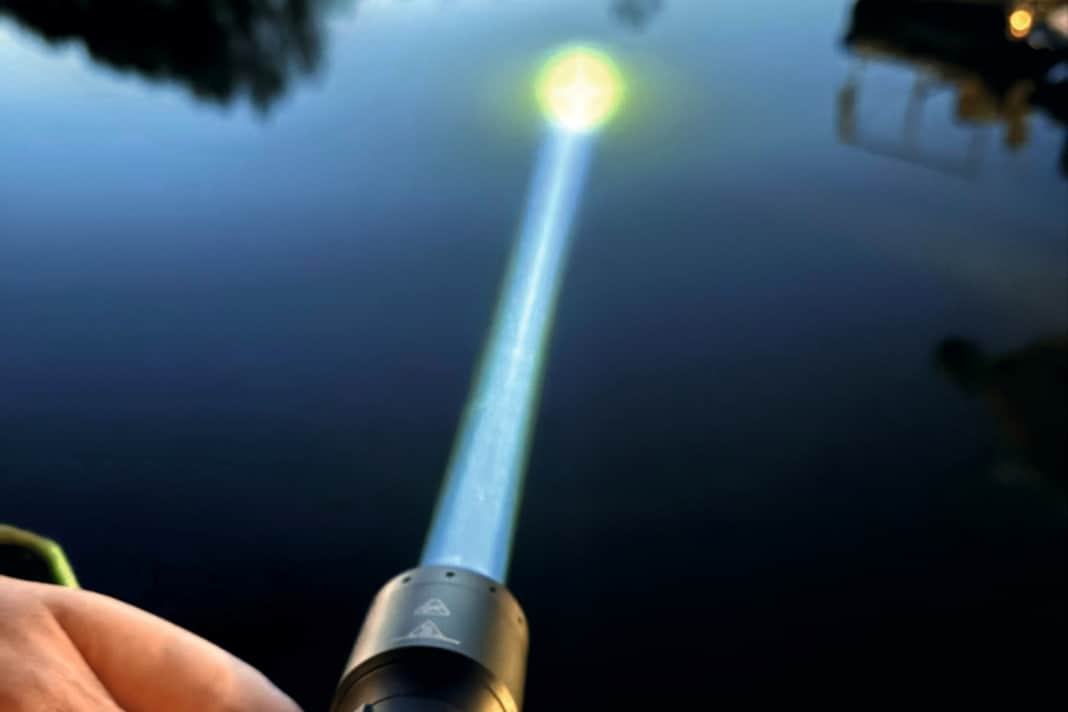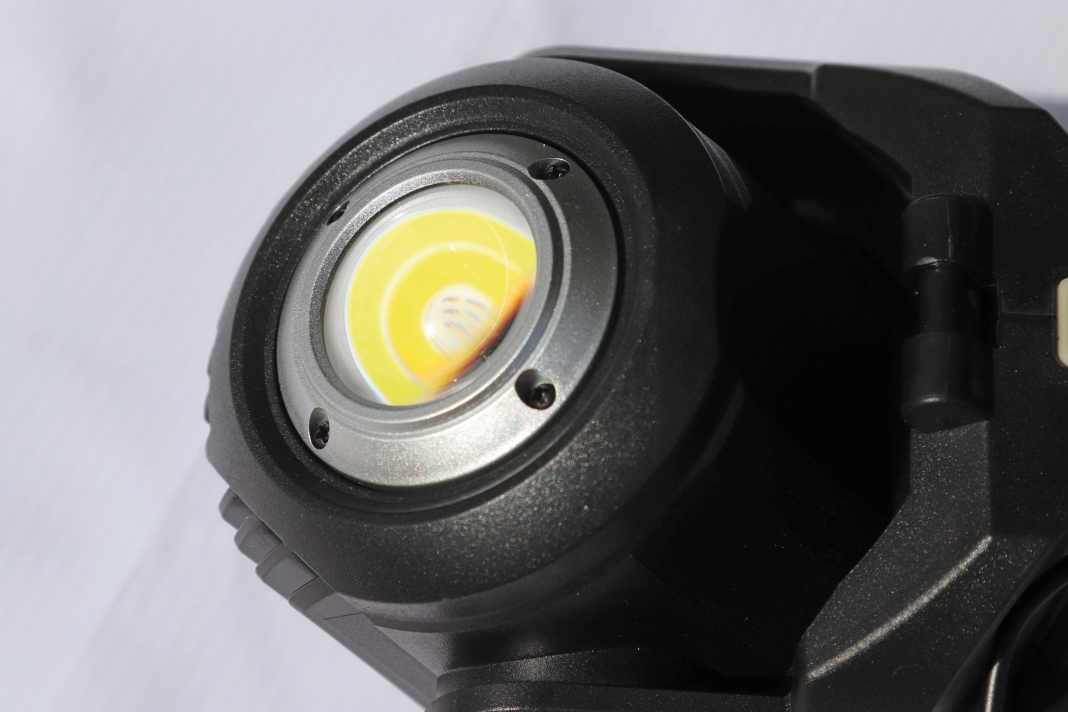




Every boat should have at least one powerful torch or, even better, a searchlight. In the past, many boats, especially larger yachts, were equipped with permanently installed searchlights for night sailing, but these days they are rarely found. The reason: modern LED handheld searchlights are so powerful that they literally put the old H3 or H4 searchlights in the shade.
This is made possible by powerful and energy-saving LEDs (light-emitting diodes) in combination with modern rechargeable battery technology, which in many cases make wired headlamps superfluous. But the best thing is that modern handheld headlamps are hardly any bigger than the previously popular torch and also offer many additional functions such as an automatic SOS flashing light, dimmable light intensity, red light for glare-free light or charging sockets for mobile phones, to name but a few.
The choice of portable spotlights
If you look in the relevant catalogues or on the websites of the well-known internet discounters, you will be overwhelmed by the selection of handheld spotlights. The prices for the products (mostly from China) start at less than 20 euros. The temptation is therefore great to buy a cheap lamp without really trying out its benefits in practice first. Reason enough for us to order a selection of no-name lamps from the online top dog Amazon and compare them with the significantly more expensive products from market leaders such as Aqua Signal, Plastimo or Ledlenser in the field.
The candidates
- Lucky Outdoor Flashlight
- Vevor MX 6005 D
- Eray T 953
- Le Tour W 5166
- Aqua Signal Cary
- Plastimo X-Spot
- Ledlenser P9R Core LEP
The results of the test
If we summarise the individual results of the handheld spotlights into an overall picture based on price, we come to the following conclusion: For occasional use, a cheap spotlight will also do. The Eray T 953, in particular, offers a variety of functions and sufficient illumination in the range up to 50 metres for its 38 euros. However, compromises in terms of feel and material quality must be accepted.
The brand products from Aqua Signal and Plastimo are better processed, waterproof and come with a practical stand. The Plastimo X-Spot is also characterised by the best illuminance among the LED lamps in the test field. It achieves the values of a car headlight and, at 127 euros, is in the mid-range price bracket. Professionals such as rescue services, the water police or even skippers who are often out on the water at night should not miss out on the unbeatable advantages of LEP technology. At 350 euros, the Ledlenser PR9 Core LEP is almost ten times more expensive than some of the no-name products, but it also offers the best quality - in every respect.
The technology in the portable spotlights
Before we get to the test, a few words about the technology of the hand-held spotlights. LED spotlights work with so-called light-emitting diodes - LEDs for short. In the past, several of these had to be combined in arrays in a lamp to achieve the required light intensity, but today a single one is usually sufficient. LEDs consist of a semiconductor material. When current flows through this material, electrons "jump" to a lower energy level and emit some of the energy difference as light - this process is called electroluminescence. Compared to traditional light bulbs, LEDs are significantly more efficient, durable and robust. Vibrations or even knocks have little effect on LEDs.
Another important advantage of this technology is that the unavoidable heat generated by conventional light bulbs is significantly lower due to the lack of a filament. This makes them many times more efficient than incandescent bulbs. The light is focussed so that it does not simply radiate in all directions. A reflector is usually used for this purpose. Its quality has an enormous influence on the light yield.
Because of these advantages, LEDs are also ideal for lighting below deck. We explain what to look out for when retrofitting in this article.
High-quality handheld spotlights also have an optical system (lens), ideally made of glass, which further concentrates the light beam and allows it to be aimed precisely, for example at a notice board, a dolphin, an obstacle or a person in the water. If, on the other hand, the light beam needs to be as wide as possible, for example to illuminate the entire foredeck or the area around the boat when mooring, either an adjustable reflector or additional LEDs on the edge of the spotlight are used. Many lamps also allow different brightness levels or even colours to be selected (marked in our table with the terms "dimmable" or "red light").
LEP instead of LED
Recently, more and more so-called LEP lamps have come onto the market, of which we also had one in the test field of hand-held headlamps, the Ledsenser PR 9 Core LEP. The biggest difference between the two technologies is their light output. In contrast to LED torches, LEP torches use a laser beam to light up phosphor and thus produce a brighter and more focussed beam of light.
This laser-like beam results in a greater range and high illuminance levels at long distances. LEP torches are also known for their better colour rendering, which can produce a more natural and accurate colour representation compared to LED torches. This is because the laser beam in LEP torches produces a narrower wavelength range, which enables better colour separation and reproduction. This is useful, for example, when differentiating between different coloured barrels or panels. However, our table shows that this new technology also comes at a price. At around 350 euros, the Ledlenser with LEP technology is anything but a bargain.
The practical test of the hand-held spotlights
For our test of the hand-held spotlights, all lamps were first charged. With the exception of the Cary from Aqua Signal, this is done via standard USB connections. A corresponding charging cable is included with all headlamps, but the charger is not. Depending on the (hopefully) available charger, the charging times will therefore vary.
The Aqua Signal lamp, on the other hand, has a conventional charging socket and the mains adapter supplied ensures a quick charge in around an hour. Alternatively, the Aqua Signal product can also be charged on the move via a cigarette lighter socket.
Another special feature can be found on the W5166 LeTour headlamp. In addition to the USB socket, it has a small solar panel which, provided the sun shines, should fully charge the headlamp in one day. All products signal their charging status via small LED displays.
Processing and functions of the hand-held spotlights
The next step was to test the handling and mechanical design of all hand-held spotlights. Not surprisingly, some of the inexpensive products differed significantly from the brand-name models. The Ledlenser PR 9 LEP is the pinnacle of workmanship. Metal housing, glass lens and belt clip make this extremely handy device (17.5 x 4.5 cm, 270 g) something special in terms of feel alone. Flashing and red light as well as IP68 water resistance round off the picture to make it the undisputed winner in this category.
Behind them are the hand lamps from Aqua Signal and Plastimo. Both are made of high-quality plastic, are waterproof for up to 30 minutes (IP67) and also have a foldable mounting bracket, which makes them suitable for use as work lights. The Aqua Signal lamp also offers an automatic SOS flashing light function, while the Plastimo X-Spot has a USB charging port for mobile phones.
Of the no-name products, only the Vevor MX 6005 comes close to the two previously mentioned. The 34-euro product is well made, protected against water to IP67 and also comes with a stand-up bracket, SOS function, different coloured plastic covers and USB charging port.
The remaining hand lamps from Lucky, Eray and LeTour have to take a back seat. The plastic finish looks cheap throughout. However, we liked the many additional functions of the LeTour lamp: the swivelling main reflector with diffused light lens, multi-coloured flashing light, solar charging surface and USB charging output are all impressive.
Special features of the LeTour headlamp




The light output
The most important test criterion for hand-held headlamps is, of course, their luminosity. Manufacturers like to specify the range and the number of lumens, if at all. It must be said that the range specification is of no practical use. Theoretically, light spreads out infinitely and could even be detected on the moon, provided the appropriate measuring technology is used. But what use is a range specification of 1,000 metres, for example, if I can no longer see anything in the weak cone of light? For comparison: the conventional high beam of a car reliably illuminates areas of up to 200 metres. Xenon or state-of-the-art laser headlights in premium vehicles reach 600 metres - after that it's all over.
The technical specification in lumens (lm) is much more meaningful. This is the unit for the luminous flux of the source. However, this value can only be determined precisely using sophisticated measurement technology in the laboratory. For example, a car high beam reaches a maximum of 1,500 lumens, whereas a candle only reaches 12 lumens.
We therefore used a lux measurement for our test of the hand-held spotlights on board. Lux (lx) is the illuminance on a certain surface. It can also be derived from the lumen value, where 1 lux equals 1 lumen per square metre. For comparison: On a full moon night, around 0.25 lux is achieved, street lighting achieves 20 lux on the carriageway and our car headlights mentioned above achieve 20 to 50 lux in the dipped beam range, depending on the technology used. The lux values we have determined should not be regarded as absolute and may vary in practice (ambient light, beam angle, haze, etc.). They only serve to compare the headlights with each other.
Back to practice. Once all the spotlights were fully charged, we waited for complete darkness and measured the illuminance (lx) as a function of the distance to the boat. Our measurement route consisted of pylons at a distance of 10 metres over a total distance of 100 metres. At the minimum distance of 10 metres, all test subjects achieved fully sufficient values between 120 lux (LeTour W5166) and a very good 1,300 lux with the Ledlenser P9R.
If we take a car headlight as a benchmark, the 50 metre range is the most interesting. As a reminder: in a car, we still have around 20 to 50 lux (with two headlights) available.
These values were achieved by the test products from Ledlenser and Plastimo (60 lx each), Eray T 953 (28 lx) and Lucky (20 lx). The reason for this is to be found less in the light intensity than in the focussing. All four are characterised by a massive focussing of the light beam. All others are broader in the truest sense of the word and illuminate the area around the boat well, but do not achieve the necessary illuminance of a vehicle headlamp.
As expected, the picture was similar at a distance of 100 metres. With 20 lux, the Ledlenser product was clearly in the lead - which means it won the test in this category. The Plastimo X-Spot was only just behind with 18 lux. The Eray spotlight followed with 8.5 lux, followed by Aqua Signal (6 lx), the Lucky (5 lx) and the Vevor and LeTour devices with just over 3 lux each - candle level.

